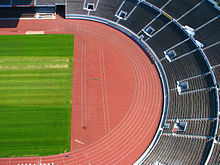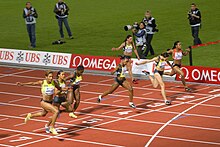User:Sce7217
I am a student at Cal Poly Pomona. I am studying Kinesiolog with an emphasis in exercise sceince. My future goal it to become a physical therapist.
school
[edit]Cal Poly Pomona I am a 4th year college student. I am on the track and field team. Cal Poly Pomona began as a satellite campus of the California Polytechnic School (today known as Cal Poly San Luis Obispo) in 1938 when a completely equipped school and farm in the city of San Dimas were donated by Charles Voorhis and his son Jerry Voorhis. The satellite campus grew further in 1949 when a horse ranch in the neighboring city of Pomona, which had belonged to Will Keith Kellogg, was acquired from the University of California. Cal Poly Pomona, then known as “Cal Poly Kellogg-Voorhis”, and Cal Poly San Luis Obispo continued operations under a unified administrative control until they became independent from each other in 1966.

hobbies
[edit]Skiing can be grouped into two general categories: Nordic and Alpine. Nordic skiing, the older of the two disciplines, originated in Scandinavia and uses free-heel bindings that attach at the toes of the skier's boots but not at the heels. Types of Nordic skiing include cross-country, ski jumping and Telemark. Alpine skiing (more often called "downhill skiing"), originated in the European Alps, and is characterized by fixed-heel bindings that attach at both the toe and the heel of the skier's boot.
Alpine skiing
[edit]Alpine skiing is also called downhill skiing. Typically, downhill skiing takes place at a ski resort with specified ski pistes or ski runs. Ski resorts that offer downhill skiing exist all over the world in cold climate areas. Non-competitive alpine skiing is recreational skiing. Also in the category of Alpine skiing are the competitions known as Slalom, Giant Slalom (GS), Super-G (Super Giant Slalom) and Downhill.
Off-road
[edit]

There are various types of off-road motorcycles, also known as 'dirt bikes', specially designed for off-road events. Compared to road-going motorcycles, off-road machines are simpler and lighter, having long suspension travel, high ground clearance, and rugged construction with little bodywork and no fairings for less damage in spills. There are specialized motorcycles for a variety of off-road motorcycle sports:
- Motocross — A short, closed off-road track with a variety of obstacles. The motorcycles have a small fuel tank for lightness and compactness. Long-travel suspension allows riders to take jumps at high speed. Motocross engines are usually single-cylinder two-stroke or four-stroke units, which vary in size from 50cc up to about 650cc. Motocross sidecar outfits have bigger engines, usually four-stroke and often twin-cylinder. Motocross bikes are also used in Freestyle Motocross.
- Enduro — A modified and road-legal motocross bike, having the addition of a horn, lights, effective silencing and a rear number plate. They compete over a longer course (which may include roads); and an enduro event will last between one day and six days.
- Rally raid, or Rallies — A special type of enduro bike but with a significantly larger fuel tank for very long distance racing, typically through deserts (e.g. Paris-Dakar rally). Engine capacities tend to be larger, usually between 450 cc and 750 cc.
- Trail —A trail bike is a dual-purpose bike, made for on-road and recreational off-road riding. A trail bike may resemble an enduro bike, but since a trail bike is not intended to be used for competition, it may be (i) less rugged, and (ii) equipped with more road legal equipment, such a indicators, mirrors and extra instruments.
- Trials — A specialized form of off-road competition testing balancing skills and precision rather than speed. For a trials bike, low weight and crisp throttle response power are the priorities, so a trials bike tends to have a small (125 cc to 300 cc) engine, two-strokes being common. During the trial, the rider stands on the footpegs, so a trials bike will have only a vestigial seat, or even no seat at all. Fuel tanks are very small, giving a very limited range. A trials outfit comprises a very light sidecar and an almost standard trials bike.
- Track racing — High-speed oval racing, typically with no brakes, no suspension, at most two gears, fuelled by methanol (not road legal machines). (Some types, such as speedway & grass-track bikes, are designed to take left turns only).
Sport
[edit] The track and field stadium is at the heart of the sport | |
| Nicknames | Track |
|---|---|
| Characteristics | |
| Team members | Yes |
| Mixed-sex | No |
| Type | Sports |
| Presence | |
| Olympic | Yes |
Track and field is a sport comprising various competitive athletic contests based around the activities of running, jumping and throwing. The name of the sport derives from the venue for the competitions: a stadium which features an oval running track surrounding a grassy area. The throwing and jumping events generally take place within the central enclosed area.
Track and field events are generally individual sports with athletes challenging each other to decide a single victor. The racing events are won by the athlete with the fastest time, while the jumping and throwing events are won by the athlete who has achieved the greatest distance or height in the contest. The running events are categorised as sprints, middle and long-distance events, relays, and hurdling. Regular jumping events include long jump, triple jump, high jump and pole vault, while the most common throwing events are shot put, javelin, discus and hammer. There are also "combined events", such as heptathlon and decathlon, in which athletes compete in a number of the above events.
Records are kept of the best performances in specific events, at world and national levels, right down to a personal level. However, if athletes are deemed to have violated the event's rules or regulations, they are disqualified from the competition and their marks are erased.
Events
[edit]Track and field events are divided into three broad categories: track events, field events, and combined events. The majority of athletes tend to specialise in just one event (or event type) with the aim of perfecting their performances, although the aim of combined events athletes is to become proficient in a number of disciplines. Track events involve running on a track over a specified distances and—in the case of the hurdling and steeplechase events—obstacles may be placed on the track. There are also relay races in which teams of athletes run and pass on a baton to their team member at the end of a certain distance.
There are two types of field events: jumps, and throws. In jumping competitions, athletes are judged on either the length or height of their jumps. The performances of jumping events for distance are measured from a board or marker, and any athlete overstepping this mark is judged to have fouled. In the jumps for height, an athlete must clear his or her body over a crossbar without knocking the bar off the supporting standards. The majority of jumping events are unaided, although athletes propel themselves vertically with purpose-built sticks in the pole vault.
The throwing events involve hurling an implement (such as a heavy weight, javelin or discus) from a set point, with athletes being judged on the distance that the object is thrown. Combined events involve the same group of athletes contesting a number of different track and field events. Points are given for their performance in each event and the athlete with the greatest points total at the end of all events is the winner.
| Track | Field | Combined events | |||||
|---|---|---|---|---|---|---|---|
| Sprints | Middle-distance | Long-distance | Hurdles | Relays | Jumps | Throws | |
| 60 m 100 m 200 m 400 m |
800 m 1500 m 3000 m |
5000 m 10,000 m |
60 m hurdles 100 m hurdles 110 m hurdles 400 m hurdles 3000 m steeplechase |
4 × 100 m relay 4 × 400 m relay |
Long jump Triple jump High jump Pole vault |
Shot put Discus throw Hammer throw Javelin throw |
Pentathlon Heptathlon Decathlon |
- Note: Events in italics are competed at indoor world championships only
- Note: Heptathlon can refer to two different events, each consisting of different disciplines and both recognised by IAAF: the indoor heptathlon for men, and the outdoor heptathlon for women.
Running
[edit]Sprints
[edit]
Races over short distances, or sprints, are among the oldest running competitions. The first 13 editions of the Ancient Olympic Games featured only one event – the stadion race, which was literally a race from one end of the stadium to the other. Sprinting events are focused around athletes reaching and sustaining their quickest possible running speed. There are three sprinting events which are currently held at the Olympics and outdoor World Championships: the 100 metres, 200 metres, and 400 metres. These events have their roots in races of imperial measurements which were later altered to metric: the 100 m evolved from the 100 yard dash,[1] the 200 m distances came from the furlong (or 1/8 of a mile),[2] and the 400 m was the successor to the 440 yard dash or quarter-mile race.
music
[edit]Country music is a popular American musical style that began in the rural Southern United States in the 1920s.[3] It takes its roots from Western cowboy and southeastern American folk music. Country music often consists of ballads and dance tunes with generally simple forms and harmonies accompanied by mostly string instruments such as banjoes, electric and acoustic guitars, fiddles such as violins, and harmonicas.[4][5][6]
The term country music gained popularity in the 1940s in preference to the earlier term hillbilly music. The term country music is used today to describe many styles and subgenres. In 2009 Country music was the most listened to rush hour radio genre during the evening commute, and second most popular in the morning commute.[7]
Pop rock is a music genre which mixes a catchy pop style and light lyrics in its (typically) guitar-based rock songs. There are varying definitions of the term, ranging from a slower and mellower form of rock music to a subgenre of pop music. Scholars have noted that pop and rock are usually depicted as opposites; the detractors of pop often deride it as a slick, commercial product, less authentic than rock music.[8]
Examples
[edit]As with many musical genres, what constitutes "pop rock" is subjective. As such, music critics and journalists have differing opinions on which category a band should be placed in. Billboard magazine provides one perspective on how to categorize "pop rock" groups from the 1970s to the 2000s. Other perspectives from other magazines and individual music journalists and critics are also provided.
2000s
[edit]The most notable pop rock performers or groups from this include artists such as Kelly Clarkson, Adam Lambert, McFly, The Jonas Brothers, Panic! At The Disco, Katy Perry, Avril Lavigne, Drake Bell, P!nk, Busted, Allstar Weekend, All Time Low, Fall Out Boy, Maroon 5.
- ^ 100 m – Introduction. IAAF. Retrieved on 26 March 2010.
- ^ 200 m Introduction. IAAF. Retrieved on 26 March 2010.
- ^ Peterson, Richard A. (1999). Creating Country Music: Fabricating Authenticity, p. 9. ISBN 0-226-66285-3.
- ^ "Country music - Definition". Dictionary.com. Retrieved 2011-10-30.
- ^ "Country music - Definition". Oxford Dictionaries. Retrieved 2011-10-30.
- ^ Country music - Definition from WordWeb http://wordweb.info/free/
- ^ ARRP Bulletin. Vol. 53 No 1. "50 Minutes on the Road. Betsy Tower. page 50. citing Communting in America III and Abritron.
- ^ S. Jones, Pop music and the press (Temple University Press, 2002), p. 109.
